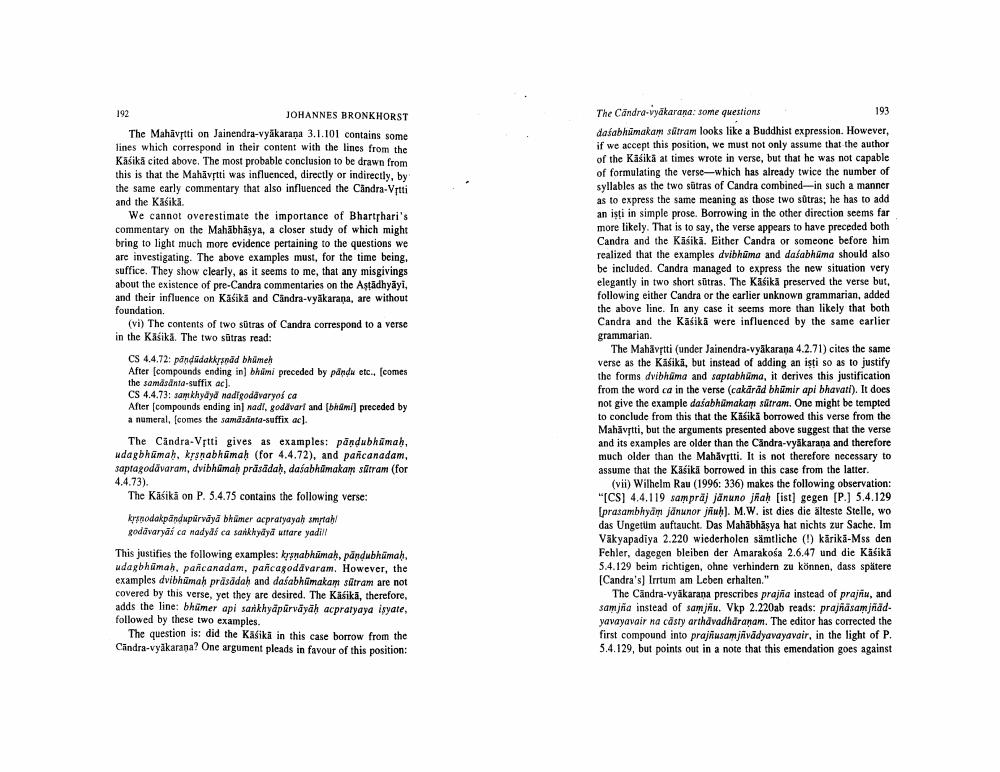Book Title: Candra Vyakarna Some Questions Author(s): Johannes Bronkhorst Publisher: Johannes Bronkhorst View full book textPage 6
________________ JOHANNES BRONKHORST The Mahävitti on Jainendra-vyäkarana 3.1.101 contains some lines which correspond in their content with the lines from the Käsikā cited above. The most probable conclusion to be drawn from this is that the Mahavṛtti was influenced, directly or indirectly, by the same early commentary that also influenced the Candra-Vitti and the Käsikā. 192 We cannot overestimate the importance of Bharthari's commentary on the Mahābhāṣya, a closer study of which might bring to light much more evidence pertaining to the questions we are investigating. The above examples must, for the time being. suffice. They show clearly, as it seems to me, that any misgivings about the existence of pre-Candra commentaries on the Aşṭādhyāyi, and their influence on Käsikä and Candra-vyakarana, are without foundation. (vi) The contents of two sutras of Candra correspond to a verse in the Käsikä. The two sūtras read: CS 4.4.72: pändüdakkṛṣṇad bhümeḥ After [compounds ending in) bhumi preceded by pandu etc., [comes the samäsänta-suffix ac] CS 4.4.73: samkhyaya nadigodavaryoś ca After [compounds ending in] nadi, godavari and [bhami] preceded by a numeral, [comes the samāsānta-suffix ac]. The Candra-Vrtti gives as examples: pandubhumaḥ, udagbhümaḥ, kṛṣṇabhamaḥ (for 4.4.72), and pañcanadam, saptagodavaram, dvibhumaḥ prāsādaḥ, daśabhūmakam sūtram (for 4.4.73). The Käsikä on P. 5.4.75 contains the following verse: kṛṣṇodakpändupurvāyā bhümer acpratyayah smrtah godāvaryaś ca nadyaś ca sankhyāyā uttare yadill This justifies the following examples: kysnabhūmaḥ, pāṇḍubhümaḥ, udagbhumaḥ, pañcanadam, pañcagodavaram. However, the examples dvibhumaḥ präsädaḥ and daśabhümakam sütram are not covered by this verse, yet they are desired. The Käsikä, therefore, adds the line: bhümer api sankhyapurväyäḥ acpratyaya isyate, followed by these two examples. The question is: did the Käsikä in this case borrow from the Candra-vyakarana? One argument pleads in favour of this position: The Candra-vyakarana: some questions 193 daśabhūmakam sutram looks like a Buddhist expression. However, if we accept this position, we must not only assume that the author of the Käsika at times wrote in verse, but that he was not capable of formulating the verse-which has already twice the number of syllables as the two sutras of Candra combined-in such a manner as to express the same meaning as those two sûtras; he has to add an işți in simple prose. Borrowing in the other direction seems far more likely. That is to say, the verse appears to have preceded both Candra and the Käsikä. Either Candra or someone before him realized that the examples dvibhuma and daśabhuma should also be included. Candra managed to express the new situation very elegantly in two short sūtras. The Käsikā preserved the verse but, following either Candra or the earlier unknown grammarian, added the above line. In any case it seems more than likely that both Candra and the Käsika were influenced by the same earlier grammarian. The Mahavṛtti (under Jainendra-vyakarana 4.2.71) cites the same verse as the Kāšikā, but instead of adding an isti so as to justify the forms dvibhuma and saptabhuma, it derives this justification from the word ca in the verse (cakärad bhumir api bhavati). It does not give the example daśabhumakam sutram. One might be tempted to conclude from this that the Käsikā borrowed this verse from the Mahāvṛtti, but the arguments presented above suggest that the verse and its examples are older than the Candra-vyākaraṇa and therefore much older than the Mahavṛtti. It is not therefore necessary to assume that the Käsikä borrowed in this case from the latter. (vii) Wilhelm Rau (1996: 336) makes the following observation: "[CS] 4.4.119 sampräj jänuno jñaḥ [ist] gegen [P.] 5.4.129 [prasambhyam jänunor jñuḥ]. M.W. ist dies die älteste Stelle, wo das Ungetum auftaucht. Das Mahābhāṣya hat nichts zur Sache. Im Vakyapadiya 2.220 wiederholen sämtliche (!) kärikä-Mss den Fehler, dagegen bleiben der Amarakośa 2.6.47 und die Käsikä 5.4.129 beim richtigen, ohne verhindern zu können, dass spätere [Candra's] Irrtum am Leben erhalten." The Candra-vyakarana prescribes prajña instead of prajnu, and samjña instead of samjñu. Vkp 2.220ab reads: prajñāsamjñādyavayavair na casty arthavadharanam. The editor has corrected the first compound into prajñusamjñvādyavayavair, in the light of P. 5.4.129, but points out in a note that this emendation goes againstPage Navigation
1 ... 4 5 6 7 8 9 10
